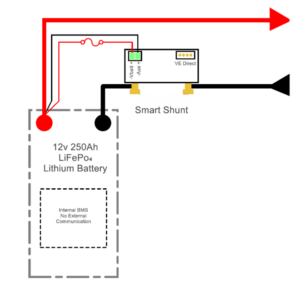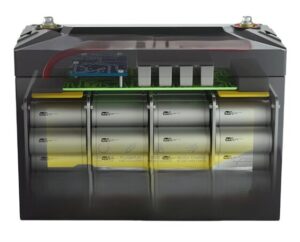Lithium Battery BMS Installation – A Surveyor’s Perspective
Mark Smith CEng, CMarEng, FIMarEST, BAppSc(MarEng) Engineering Surveyor Accredited Marine Surveyor: AMSA – 3242-6148 4 Qld EC lic. 73995 Authorised Maritime NZ Surveyor – SRV242
As the maritime industry increasingly adopts lithium batteries, the surveyor’s role in evaluating these installations plays an important and integral role. While Suppliers promote the benefits and ease of installation, not all lithium battery BMS configurations meet the required standards.
The first thing to understand is that when considering an energy system using batteries, this is fundamentally an off-grid system, and consideration must be given to designing and installing it. The primary guidance is provided in AS/NZS 3004.2 for boat electrical installations, but another important standard is AS/NZS.
An internal BMS must be able to communicate with inverters and charging systems and provide warning alarms.
The DCV Surveyor’s ability to independently assess the advice and documentation from the electrical installer regarding the compliance of lithium batteries for ELV and LV installation is not just crucial, but a testament to the trust placed in their expertise. This independent judgment ensures that the installation meets the necessary safety standards, making the Surveyor a key player in the process.
For example, the circuit wiring below (Fig: 1) is a system that was presented to me, and I was advised that the supplier had said this was a compliant installation.
Fig: 1 – Proposed compliant system for battery monitoring

The suggestion was that the above configuration complies with NSCV and AS/NZS 3004.2, based on the assumption that the internal BMS and the Smart Shunt are in communication. After consulting The Company, they indicated that the fitting of a Smart Shunt does not meet the compliance requirements of the standard for lithium batteries with an internal BMS with no communication ports.
This arrangement was then not approved, as it was not compliant for two reasons:
- Not meeting the requirement of the Standard, as the fitted BMS had no communication ports fitted to allow comms between such systems as power conversion equipment, charging systems, alarms, and cooling systems (if applicable).
- Outboard engine charging (alternator failure).
Interesting reference article
https://www.victronenergy.com/blog/2019/10/07/careful-alternator-charging-lithium/
This is but one of the many areas in which a Surveyor needs to have sufficient knowledge to engage with the installer to determine the type of installation and if the BMS meets its compliance for the configuration for the required communication.
Generally, this information is available in online forums that provide guidance notices and factsheets. To date, I have not been able to locate any guidance notices and factsheets related to lithium battery installations that are useful to pass on for reference to Surveyors.
This article aims to start a discussion regarding lithium battery installations and develop guidance notes to assist Surveyors when inspecting them.
Firstly, it is important to use AS/NZS 3004.2, Section 2.9.3—Additional requirements for lithium-ion batteries as a baseline guide. The following guidance notes that I used may be helpful to others. This is not a definitive list by any means and is just a starting point to create a forum to discuss and help Surveyors develop their own guidance notes. This will help in the survey process of identifying safety issues involving lithium batteries.
The following clauses in Dark Grey are from Section 2.9.3 of the Standard:
- Lithium-ion batteries shall be installed in locations that ensure the battery manufacturer’s specified operating temperature limits cannot be exceeded and are appropriate for the battery and its management system’s IP rating.
Guidance Notes:
- Batteries of mixed chemistry are not to be stored in the same enclosure.
- Check the IP ratings for all systems (e.g. Inverters are not generally rated for mounting in engine rooms).
Each lithium-ion battery shall be provided with a battery management safety system (BMS) integrated into a battery pack or as a separate component adjacent to the battery. The BMS shall continuously monitor the voltage and temperature of each cell in the battery.
Guidance Notes:
- The BMS monitors the voltage and temperature of each cell. This is typically not how these are observed, as the cells are grouped into packs of 4, with this pack’s voltage being monitored, and a single temperature probe is fitted to detect a rise in temperature within the casing (Fig: 2).
Fig: 2 – Typical internal arrangement for a Lithium Battery

- This arrangement does not fulfil the clause in the Standard requireing each cell’s voltage and temperature be monitored. There are two observations to make for this battery-type BMS configuration for voltage and temperature monitoring:
- Each cell is not monitored for voltage but for a series of cells.
- Each cell is not monitored for temperature; only the internal moulded casing is monitored.
However, it may be reasonable to consider that if everything is mounted within a moulded casing, the lithium battery is compliant only for a single 12-volt battery system.
The other problem that arises is when lithium batteries are placed in parallel or series. How will these batteries with internal BMS communicate with each other if they are not fitted with comms ports?
- The BMS shall automatically disconnect all charging sources when the voltage exceeds the manufacturer’s recommended maximum.
Guidance Notes:
- With a single charging source and a single 12V lithium battery, the internal BMS will meet some of the requirements without communication ports.
- Internal BMS with no comms does not provide an audible or visual alarm to external devices.
- A further problem is if the batteries are in parallel or series, as when a battery shuts down due to a warning or fault. It should be able to communicate with other batteries and devices, such as power conversion equipment, charging systems, alarms, and cooling systems.
- Lithium batteries generally require a DC/DC charger (reference VICTRON Web page: Careful – Alternator Charging Lithium).
The BMS automatically disconnects all connected loads when the voltage falls below the manufacturer’s recommended minimum.
Guidance Notes:
- See Guidance Notes clause c).
- When the temperature exceeds the manufacturer’s specified maximum, the BMS shall automatically disconnect the battery from all connected loads and all charging sources.
Guidance Notes:
- See Guidance Notes clause c).
- The BMS shall provide an audible and visual alarm at the normal vessel operating position before a disconnection occurs.
Guidance Note:
- An internal BMS fitted without communication ports cannot provide an audible and visual alarm at the normal vessel operating position before a disconnection event occurs and is therefore NOT compliant.
- Lithium-ion battery ventilation air flows shall meet the manufacturer’s requirements. Clauses 2.9.2.2 or 2.9.2.3 requirements shall be applied if specific air flow data is not provided.
NOTE: Care must be exercised when disabling charging sources to avoid the risk of elevated voltages that may damage the equipment.
Guidance Notes:
- Ensure adequate venting is available, as lithium batteries generate significant heat.
- Lithium batteries generally require a DC/DC charger (reference VICTRON Web page: Careful – Alternator Charging Lithium).
- An internal BMS fitted without communication ports cannot provide a signal to operate cooling systems.
A further important development about BMS is the recent review of AS/NZS3004.2 concerning batteries with an internal BMS. It has been proposed to adopt the notion that communication can be a wired or wireless configuration. This reference to wireless is a direct pull out of the recently released AS/NZS 3001.2:2022 Electrical installations –Part 2: Connectable electrical installations—Clause 5.4.12.3.4.
Currently, the monitoring via Bluetooth conductivity to an app means the following parameters of the State of Charge data are displayed:
- Battery voltage
- Battery current
- Power
The failure here is that these apps do not communicate with other devices to control shutdowns of battery banks, power conversion equipment, loads, charging and cooling systems or initiate BMS alarms.
This may be an appropriate system for land-based Recreational Vehicles in that if it all goes wrong, you can pull the car over to the side of the road and get out to watch it burn at a safe distance. However, if it all goes wrong, a vessel at sea, the last thing you want to do is get off into the water and be reliant on lifesaving appliances while you watch it burn.
An old seafarer’s adage is, “Always step up to lifesaving appliances and never step down”. That is to say that the last option is to get into the water. To avoid this option, warning alarms inform you of a problem before it becomes critical, allowing you to take corrective action or suppress fires before the situation gets out of hand.
SUMMARY
The issue highlighted is that batteries with an internal BMS and no communication ports fitted cannot communicate with other batteries and devices, such as power conversion equipment, charging systems, alarms, and cooling systems.
The fitting of a Smart Shunt will not overcome this problem, as it does not communicate with the BMS but operates independently of it and monitors the following State of Charge data:
- Battery voltage
- Battery current
- Power
- Aux input reading (starter battery, midpoint or temperature)
These above monitoring parameters do not fully cover the requirements as set out in the BMS standard and do not allow for an alarm relay like the VICTRON BMV series hardware, for example.
Therefore, a lithium battery with an internal BMS must have communication capability with other batteries and devices, such as power conversion equipment, charging systems, alarms, and cooling systems, to work effectively.
To clarify further, I have referenced *AS/NZS 5139:2019 – Electrical installations — Safety of battery systems for power conversion equipment to further explain this matter. From this Standard in Clause 1.3.16 (and I paraphrase):
BMS – Electronical system that monitors and manages a battery or system’s electrical and thermal states, enabling it to operate within its safe region for the particular battery. The BMS communicates between the battery or battery system, the power control equipment, and potentially other devices.
Quite simply, lithium batteries with an internal BMS and no communication ports do not provide the level of safety required for marine installations. Additionally, Bluetooth-connected devices do not communicate with other devices to control other batteries, power conversion equipment, loads, charging and cooling systems. Also, there is reliance on an app that will turn off after the connected device (iPhone, iPad, etc.) is powered down. Once the connected device is powered up, user intervention is required to turn the app back on.
* Note: When researching safety compliance standards, it is a good practice to reference other standards, guidelines, and class rules to provide additional clarity on clauses